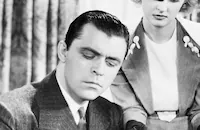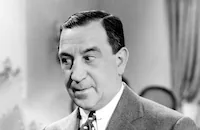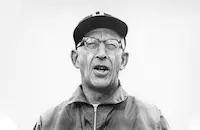She Had to Say Yes

Brief Synopsis
Cast & Crew
Busby Berkeley
Loretta Young
Winnie Lightner
Lyle Talbot
Regis Toomey
Hugh Herbert
Film Details
Technical Specs

Synopsis
Sol Glass's clothing business is losing sales because the "customer girls," the women employed to entertain buyers from out of town, are not friendly enough. Salesman Tommy Nelson suggests using stenographers to entertain buyers, who he believes are tired of gold diggers. When his fiancée, Florence Denny, wants to participate in the program, however, Tommy refuses to let her. Birdie, one of the other stenographers, becomes a very successful customer girl, closing many sales, and Tommy, too, succumbs to her charms. One night, when he has a date with Birdie, Tommy suggests that Florence go out with buyer Daniel Drew. She is surprised, but agrees in order to earn a commission for Tommy so that they can afford to get married. She likes Daniel, but is horrified when he expects her to spend the night and flees from his hotel. She has a further blow when her friend, Maizee, reveals Tommy's affair with Birdie. She breaks her engagement, and is now willing to accept Daniel's apology. While he is on the road, Daniel phones and writes and they become friends. Meanwhile, Tommy tells Florence she is acquiring a bad reputation, using that as an excuse to offer her money to get together with him. This encounter convinces Florence to quit her work as a customer girl. Daniel, who is now deeply in love with Florence, returns to town. He asks her help in completing a merger. Although she is disappointed by his request, she agrees and gets the necessary signature, without compromising herself. Daniel, however, does not believe what she did was so innocent, especially when the buyer hints that she blackmailed him into signing. Convinced that her refusals were just a ploy, Daniel drives her into the country, where he attacks her. She escapes to find Tommy in a taxi, but when she begs him for help, he, too, believes that she is selling herself. Daniel overhears Tommy's accusations and, realizing that Florence is really innocent, makes Tommy apologize. He also begs her forgiveness and asks her to marry him.

Cast

Loretta Young

Winnie Lightner

Lyle Talbot

Regis Toomey

Hugh Herbert
Ferdinand Gottschalk
Suzanne Kilborn
Helen Ware
Harold Waldridge
Tom Dugan

Charles Levinson

Joseph Cawthorne
Crew

Film Details
Technical Specs

Articles
She Had to Say Yes
One of the movie's jaw-dropping moments, before a traditional happy ending, involves Talbot's near-rape of an unconscious Young. In her book A Woman's View, film historian Jeanine Basinger, called She Had to Say Yes "a smarmy, mean little Depression movie" that "puts the capper on showing how women are used by men." A promotional teaser for the movie put it a little more discreetly: "We apologize to the men for the many frank revelations made by this picture, but we just had to show it as it was filmed. The true story of the working girl."
The 20-year-old Young's blend of innocence and sexual allure made her perfect casting for her role. This was the hard-working actress's eighth of nine pictures released in 1933, and her final one under a contract with Warner Bros. that began in 1929. It was her second film with Talbot (the first was The Life of Jimmy Dolan, also released in 1933), and there were rumors of a brief romance during filming.
Dance director Busby Berkeley made his directorial debut here, sharing the credit with veteran editor/director George Amy. Berkeley would say later that he "learned a lot from George about the technical business of cutting and editing, which helped me greatly in building my own technique." Berkeley also had kind words for his star: "Loretta, with those marvelous big gray eyes of hers, was a charming girl to work with. She had...a ladylike quality that is rather uncommon among actresses."
Character actress Winnie Lightner, in the role of Young's pal Maizee, has some of the movie's best lines. At one point she informs an overeager suitor that "I'm from the Virgin Islands." And she warns a fellow "customer girl": "Look out. A bonus isn't the only thing you can get from an out-of-town buyer!"
Directors: George Amy, Busby Berkeley
Screenplay: Rian James, Don Mullaly, based on the story "Customer's Girl" by John Francis Larkin
Cinematography: Arthur L. Todd
Editing: George Amy
Art Direction: Esdras Hartley
Costumes: Orry-Kelly
Cast: Loretta Young (Florence 'Flo' Denny), Winnie Lightner (Maizee), Lyle Talbot (Daniel 'Danny' Drew), Regis Toomey (Tommy Nelson), Hugh Herbert (Luther Haines), Ferdinand Gottschalk (Sol Glass).
BW-66m. Closed Captioning.
by Roger Fristoe

She Had to Say Yes
Quotes
Trivia
Notes
John Francis Larkin's screen story was entitled "Customer Girl." According to a Warner Bros. production chart included in the file on the film at the AMPAS library, the film took seventeen days to shoot and was made for a total cost of $111,000. Modern sources note that because this was Busby Berkeley's first directorial assignment, veteran editor George Amy was assigned as co-director. This was also Amy's first directorial assignment. Henry Blanke supervised, according to modern sources.
















